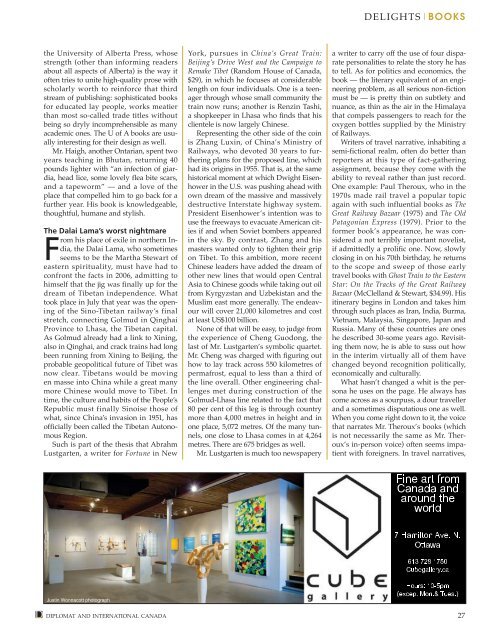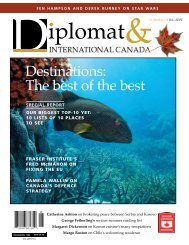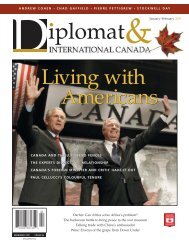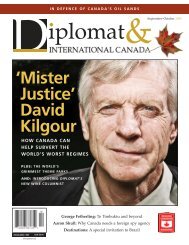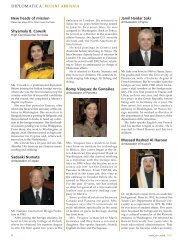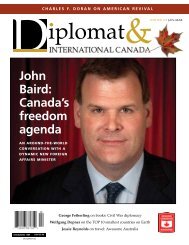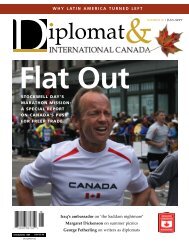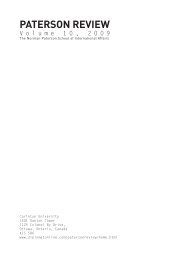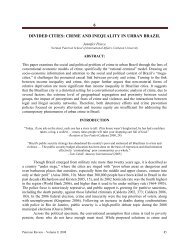Lord Jim of Dilling - Diplomat Magazine
Lord Jim of Dilling - Diplomat Magazine
Lord Jim of Dilling - Diplomat Magazine
- No tags were found...
You also want an ePaper? Increase the reach of your titles
YUMPU automatically turns print PDFs into web optimized ePapers that Google loves.
DELIGHTS|Booksthe University <strong>of</strong> Alberta Press, whosestrength (other than informing readersabout all aspects <strong>of</strong> Alberta) is the way it<strong>of</strong>ten tries to unite high-quality prose withscholarly worth to reinforce that thirdstream <strong>of</strong> publishing: sophisticated booksfor educated lay people, works meatierthan most so-called trade titles withoutbeing so dryly incomprehensible as manyacademic ones. The U <strong>of</strong> A books are usuallyinteresting for their design as well.Mr. Haigh, another Ontarian, spent twoyears teaching in Bhutan, returning 40pounds lighter with “an infection <strong>of</strong> giardia,head lice, some lovely flea bite scars,and a tapeworm” — and a love <strong>of</strong> theplace that compelled him to go back for afurther year. His book is knowledgeable,thoughtful, humane and stylish.The Dalai Lama’s worst nightmareFrom his place <strong>of</strong> exile in northern India,the Dalai Lama, who sometimesseems to be the Martha Stewart <strong>of</strong>eastern spirituality, must have had toconfront the facts in 2006, admitting tohimself that the jig was finally up for thedream <strong>of</strong> Tibetan independence. Whattook place in July that year was the opening<strong>of</strong> the Sino-Tibetan railway’s finalstretch, connecting Golmud in QinghaiProvince to Lhasa, the Tibetan capital.As Golmud already had a link to Xining,also in Qinghai, and crack trains had longbeen running from Xining to Beijing, theprobable geopolitical future <strong>of</strong> Tibet wasnow clear. Tibetans would be movingen masse into China while a great manymore Chinese would move to Tibet. Intime, the culture and habits <strong>of</strong> the People’sRepublic must finally Sinoise those <strong>of</strong>what, since China’s invasion in 1951, has<strong>of</strong>ficially been called the Tibetan AutonomousRegion.Such is part <strong>of</strong> the thesis that AbrahmLustgarten, a writer for Fortune in NewYork, pursues in China’s Great Train:Beijing’s Drive West and the Campaign toRemake Tibet (Random House <strong>of</strong> Canada,$29), in which he focuses at considerablelength on four individuals. One is a teenagerthrough whose small community thetrain now runs; another is Renzin Tashi,a shopkeeper in Lhasa who finds that hisclientele is now largely Chinese.Representing the other side <strong>of</strong> the coinis Zhang Luxin, <strong>of</strong> China’s Ministry <strong>of</strong>Railways, who devoted 30 years to furtheringplans for the proposed line, whichhad its origins in 1955. That is, at the samehistorical moment at which Dwight Eisenhowerin the U.S. was pushing ahead withown dream <strong>of</strong> the massive and massivelydestructive Interstate highway system.President Eisenhower’s intention was touse the freeways to evacuate American citiesif and when Soviet bombers appearedin the sky. By contrast, Zhang and hismasters wanted only to tighten their gripon Tibet. To this ambition, more recentChinese leaders have added the dream <strong>of</strong>other new lines that would open CentralAsia to Chinese goods while taking out oilfrom Kyrgyzstan and Uzbekistan and theMuslim east more generally. The endeavourwill cover 21,000 kilometres and costat least US$100 billion.None <strong>of</strong> that will be easy, to judge fromthe experience <strong>of</strong> Cheng Guodong, thelast <strong>of</strong> Mr. Lustgarten’s symbolic quartet.Mr. Cheng was charged with figuring outhow to lay track across 550 kilometres <strong>of</strong>permafrost, equal to less than a third <strong>of</strong>the line overall. Other engineering challengesmet during construction <strong>of</strong> theGolmud-Lhasa line related to the fact that80 per cent <strong>of</strong> this leg is through countrymore than 4,000 metres in height and inone place, 5,072 metres. Of the many tunnels,one close to Lhasa comes in at 4,264metres. There are 675 bridges as well.Mr. Lustgarten is much too newspaperya writer to carry <strong>of</strong>f the use <strong>of</strong> four disparatepersonalities to relate the story he hasto tell. As for politics and economics, thebook — the literary equivalent <strong>of</strong> an engineeringproblem, as all serious non-fictionmust be — is pretty thin on subtlety andnuance, as thin as the air in the Himalayathat compels passengers to reach for theoxygen bottles supplied by the Ministry<strong>of</strong> Railways.Writers <strong>of</strong> travel narrative, inhabiting asemi-fictional realm, <strong>of</strong>ten do better thanreporters at this type <strong>of</strong> fact-gatheringassignment, because they come with theability to reveal rather than just record.One example: Paul Theroux, who in the1970s made rail travel a popular topicagain with such influential books as TheGreat Railway Bazaar (1975) and The OldPatagonian Express (1979). Prior to theformer book’s appearance, he was considereda not terribly important novelist,if admittedly a prolific one. Now, slowlyclosing in on his 70th birthday, he returnsto the scope and sweep <strong>of</strong> those earlytravel books with Ghost Train to the EasternStar: On the Tracks <strong>of</strong> the Great RailwayBazaar (McClelland & Stewart, $34.99). Hisitinerary begins in London and takes himthrough such places as Iran, India, Burma,Vietnam, Malaysia, Singapore, Japan andRussia. Many <strong>of</strong> these countries are oneshe described 30-some years ago. Revisitingthem now, he is able to suss out howin the interim virtually all <strong>of</strong> them havechanged beyond recognition politically,economically and culturally.What hasn’t changed a whit is the personahe uses on the page. He always hascome across as a sourpuss, a dour travellerand a sometimes disputatious one as well.When you come right down to it, the voicethat narrates Mr. Theroux’s books (whichis not necessarily the same as Mr. Theroux’sin-person voice) <strong>of</strong>ten seems impatientwith foreigners. In travel narratives,Fine art fromCanada andaround theworldJustin Wonnacott photograph7 Hamilton Ave. N.Ottawa613 728 1750Cubegallery.caHours: 10-5pm(except Mon.& Tues.)diplomat and international canada 27


